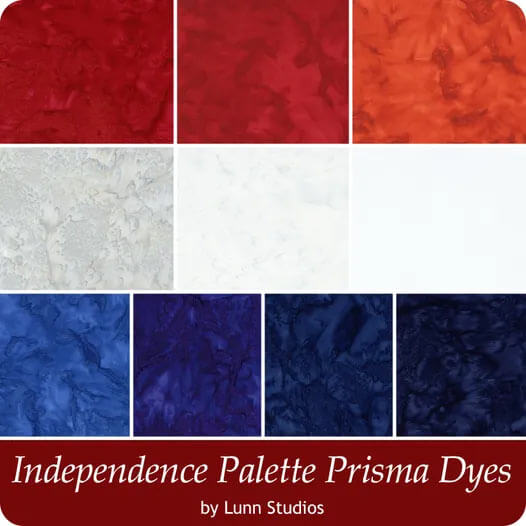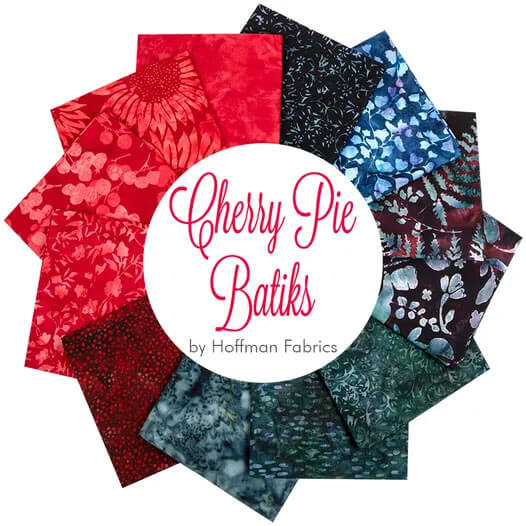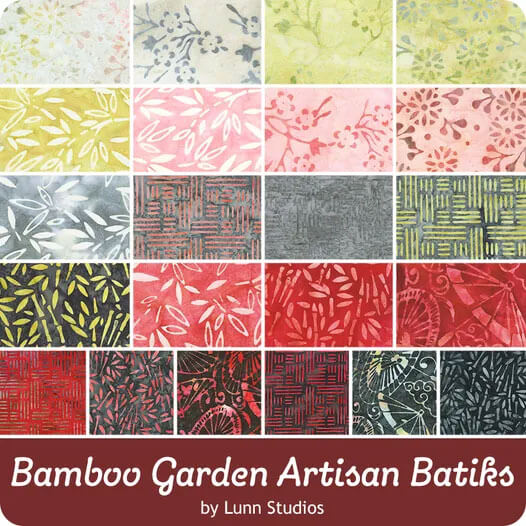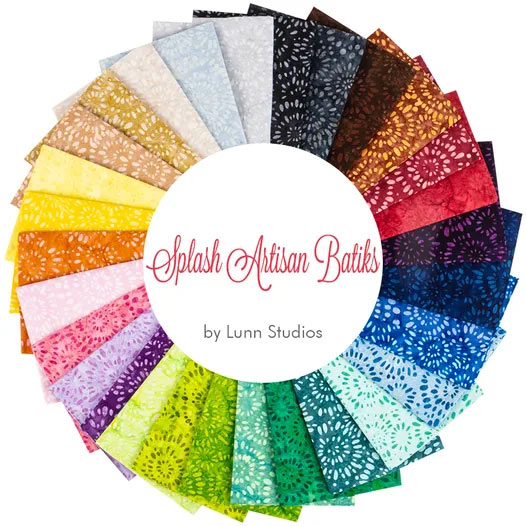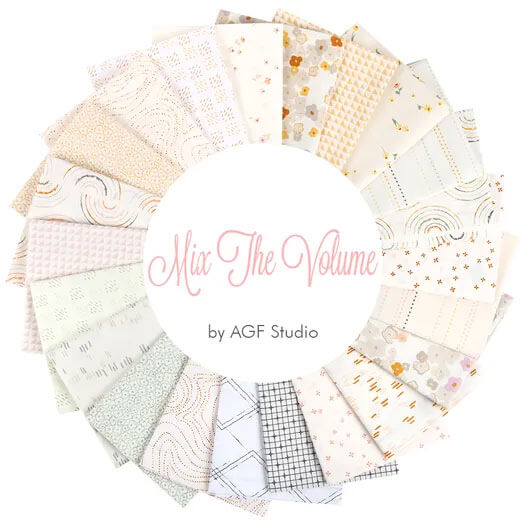- Home
- Free Quilt Block Patterns
- Five Patch Quilt Block
Five Patch Quilt Block Instructions
From our Free Quilt Block Patterns Library
This post contains affiliate links, for which I receive compensation.
Skill Level: Beginner
The beginner-friendly Five Patch quilt block is made with strip-pieced 9 patches.
Like all blocks with a nine patch in the corner, you can easily create a chain design with the addition of a simple alternate block.
Cutting instructions for that alternate block are found at the end of this page.
So what does it look like in a quilt?
Six different quilt designs using this block are shared to inspire you!
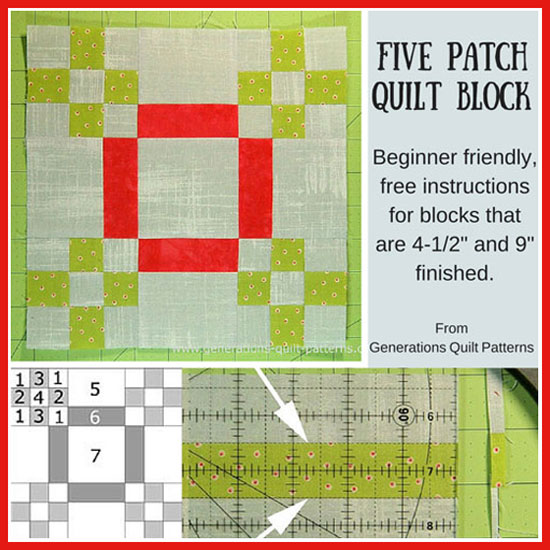
Not quite the 'chain' block you were looking for?
Click here for more blocks that form chain designs.
📋 General Instructions
These abbreviations are used in this tutorial:
- SA - seam allowance
- RST - right sides together
- Bac - background fabric
Seam allowances (SA) are all 1/4".
Unless otherwise indicated, SA are pressed toward the darker fabric.
The newest quilt fabrics to tickle your fancy...
Click the images below to see the full collection. We share any commercial and/or free patterns that showcase them, too. (For inspiration, of course!)
Step 1: Cutting for a Five Patch block
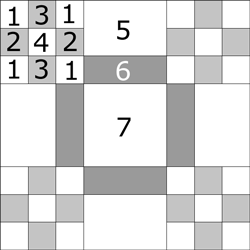 Five Patch design
Five Patch designSample Size: 9" finished / 9½" unfinished
Grid: 9x9
Attribution: Ladies Art Company
AKA: Glorified Nine Patch (Evelyn Brown)
Design Type: Blocks that form chain, Even 9-patch
Choose fabrics with enough contrast between them so that the chains show up in the design.
For a 4-1/2" block, fabrics that read as solids are the best choice due to the small patch size. Save the large scale prints for larger blocks.
Patches #1-#6 are used in strip sets and are cut a bit longer than needed.
 |
Cutting Chart for a~ Traditional Piecing ~ | |||
|---|---|---|---|---|
| Patch | Fabric | Qty | Finished Block Size | |
| 4 1/2" | 9 " | |||
| 1 | Bac | 2 | 1” x 9” | 1 1/2” x 13” |
| 2 | M | 1 | 1” x 9” | 1 1/2” x 13” |
| 3 | M | 2 | 1” x 5” | 1 1/2” x 7” |
| 4 | Bac | 1 | 1” x 5” | 1 1/2” x 7” |
| 5 | Bac | 1 | 1 1/2” x 9” | 2 1/2” x 15” |
| 6 | D | 1 | 1” x 9” | 1 1/2” x 15” |
| 7 | Bac | 1 | 2”sq | 3-1/2”sq |
| Unfinished Block Size | 5 " | 9 1/2" | ||
| Grid Size | 1/2" | 1 " | ||
Step 2: Create the units for the Five Patch
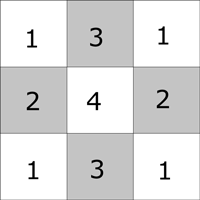
Nine Patch
Make 4
With right sides together (RST) stitch a #1 to a #2. Stitch a #3 and a #4 to each other. Press.
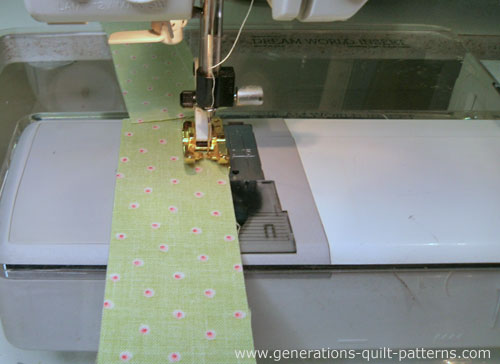 The guide on my quarter inch foot makes sewing strip sets together virtually foolproof!
The guide on my quarter inch foot makes sewing strip sets together virtually foolproof!Alternating fabrics, add the second #1 to the #1/#2 strip set; add the second #3 to the #3/#4 pair. Press.
Straighten a short edge on each by lining up lines on your ruler with the seam lines (arrows)—this is also a quick double check that your SA was accurate.
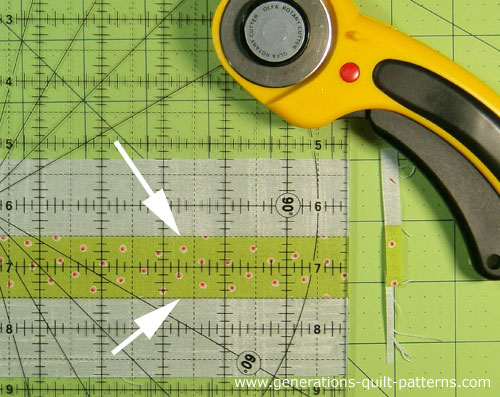 Straightening the edge of the #1/#2/#1 patch
Straightening the edge of the #1/#2/#1 patchUse the chart below to subcut each strip set. Cut eight units from the #1/#2/#1 unit and four from the #3/#4/#3.
| Nine Patch Units | ||
|---|---|---|
| Finished Block Size | Stripset Width | Subcut Width |
| 4-1/2” | 2” | 1” |
| 9” | 3 1/2” | 1 1/2” |
Arrange the subcut units into nine patches. This design has the lighter, background fabric in the corners. (below, left)

With RST, join pairs together and press. Add the third unit to each pair (above, right) for a total of four 9-patches.
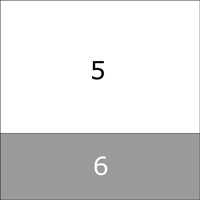
Sides
Make 4
With RST stitch the #5 and #6 together along the long edge. Press.
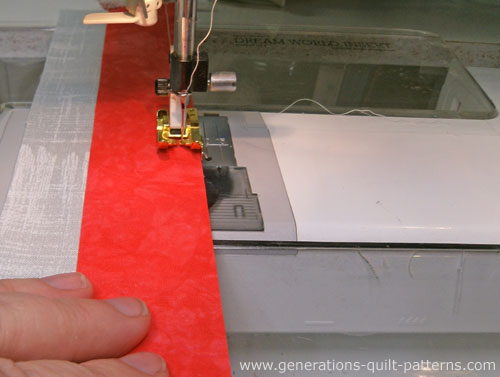
Use the chart below to check that your stripset is the correct width after stitching.
Straighten a short edge with your rotary cutter.
Cut four units equal to the 'Subcut Width' below.
| Side Units | ||
|---|---|---|
| Finished Block Size | Stripset Width | Subcut Width |
| 4-1/2” | 2” | 2” |
| 9” | 3 1/2” | 3 1/2” |
You now have...
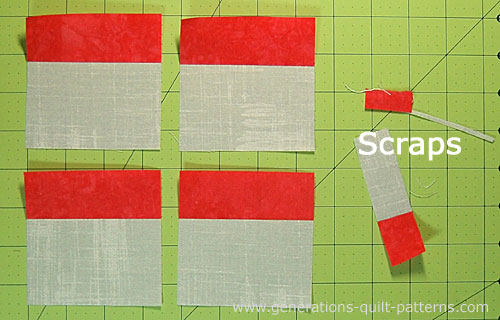 There is a bit leftover on purpose.
There is a bit leftover on purpose.Step 3: Assemble the Five Patch quilt block
Arrange the units to create the Five Patch design.
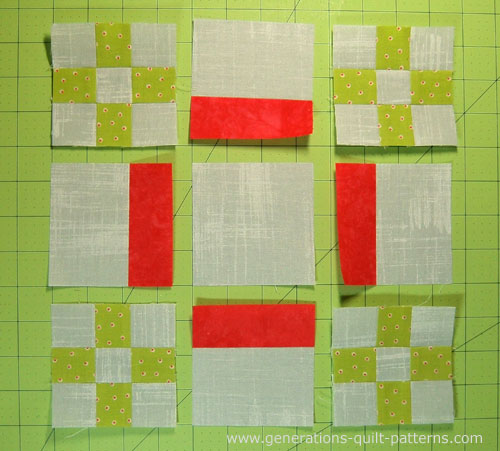
With RST, stitch the patches into rows. The SA nest nicely to make matching them a breeze.
SAs are pressed toward the Side units, i.e. away from the 9-patches and towards the solid center square.
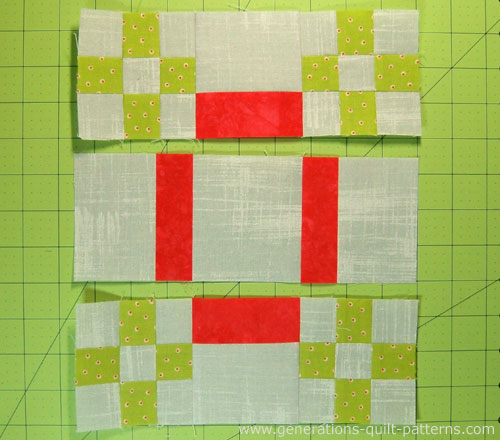
To finish the block, stitch the rows together. Press.
Your Five Patch quilt block looks like this!
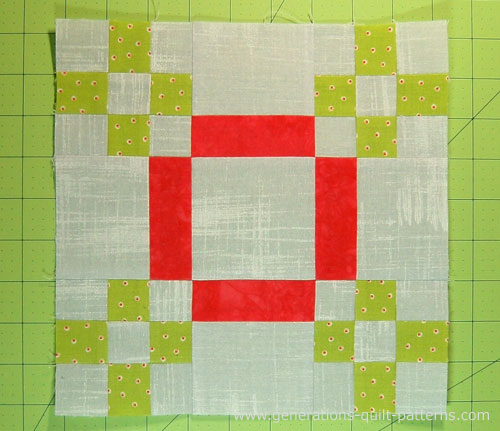
Designing with the Five Patch quilt block
I've switched to a monochromatic color scheme for the patchwork designs that follow. The same exact coloring of the block is used for all six examples.
In this first one, Five Patch blocks are stitched edge-to-edge in a straight set. A nice secondary pattern appears at the corners of the blocks.
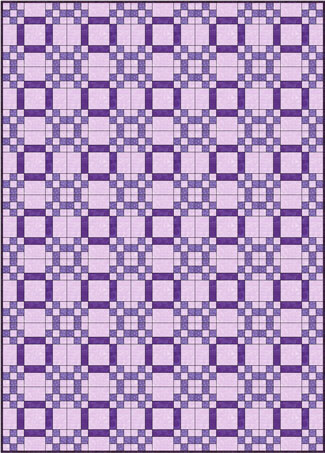
5x7
A simple sashing made of background fabric and a cornerstone in the medium value fabric is added to our design. Naturally, the secondary pattern changes. This design is a bit more open and airy.
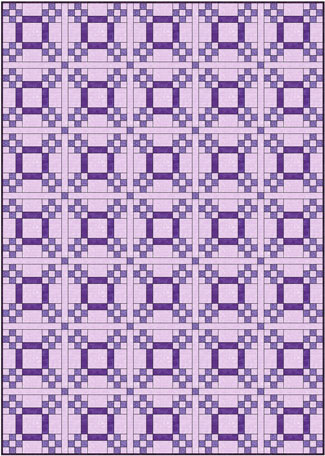
5x7
Next, the blocks are turned on-point and set edge-to-edge with no sashing.
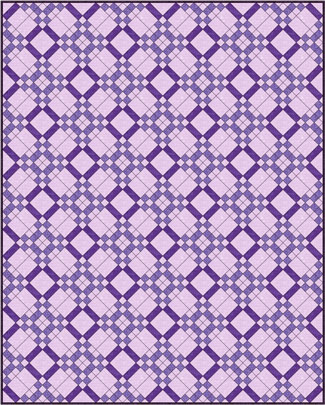
4x5
This time when the sashing is added, a dark value cornerstone is used.
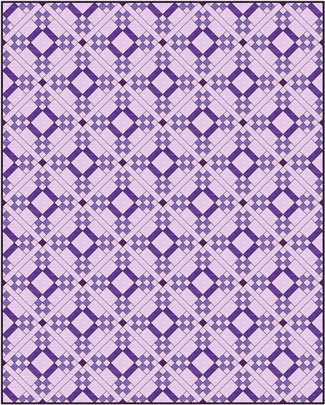
4x5
In this last design, it's interesting to see how the sashing reduces the dominance of the dark square. I didn't expect that!
Note, too, that for all the quilt designs so far it doesn't matter whether there are even or odd numbers of blocks in the rows and columns. The design is symmetrical either way. That gives you more options when you're designing a quilt to fit a particular bed.
Adding an alternate block
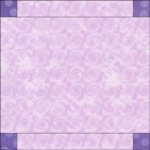
When paired with this simple alternate block a traditional-looking 'chain' design is created.
It's shown here first in a straight set. To maintain design symmetry you need odd numbers of blocks in the rows and columns.
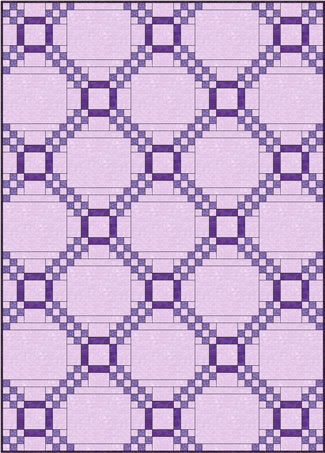
5x7
And now with the blocks on-point.
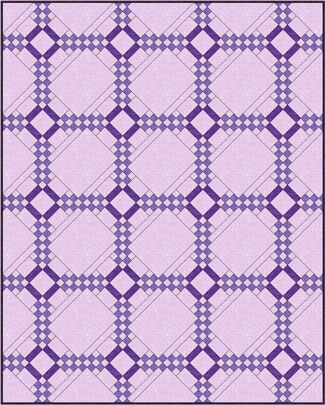
4x5
Here the quilt is symmetrical regardless of the numbers of blocks in the rows and columns.
Cutting Chart for an Alternate Block
 |
Cutting Chart for a~ Traditional Piecing ~ | ||||
|---|---|---|---|---|---|
| Patch | Fabric | Qty | Finished Block Size | 4 1/2" | 9" |
| 1 | M | 4 | 1” x 1” | 1 1/2” x 1 1/2” | |
| 2 | Bac | 2 | 1” x 4” | 1 1/2” x 7 1/2” | |
| 3 | Bac | 1 | 4” x 5” | 7 1/2” x 9 1/2” | |
| Unfinished Block Size | 5" | 9 1/2" | |||
| Grid Size | 1/2” | 1” | |||
With RST sew a #1 to both ends of a #2, pressing SA toward #2. Repeat for a total of two.
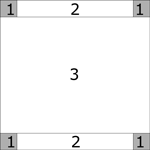
Stitch one #1/#2/#1 to each long side of #3. Press.
The alternate block is complete.
Click here for more blocks that form chain designs.
What about a different quilt block?
For a list of all the 220+ quilt block patterns on this site, start here.
If you know the name of the block, shorten your search by using these links:
Click here if you're looking for blocks with at least some paper piecing.
Click here if you're looking for the basic building blocks of quilting, i.e., Flying Geese, half square triangles, quarter square triangles, etc., along with several techniques to make each.
And finally, use these links to find blocks in these finished sizes:
